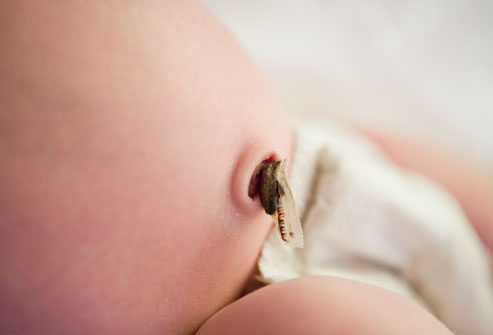 The umbilical cord plays a vital role during pregnancy by delivering oxygen and nutrients to the baby during its growth. The umbilical cord is connected to the baby’s belly and it must be cut after birth. Once the umbilical cord is cut, an umbilical stump of about 2-3 cm in length will remain on the baby’s bellybutton. After around five days, the stump should begin to dry out and turn black, although this can take anywhere up to fifteen days, the stump should then proceed to fall off. This can result in the stump of the umbilical cord bleeding as it achieves separation. It is important to know when this may be a problem and to ensure you are able to care for your child if bleeding occurs.
The umbilical cord plays a vital role during pregnancy by delivering oxygen and nutrients to the baby during its growth. The umbilical cord is connected to the baby’s belly and it must be cut after birth. Once the umbilical cord is cut, an umbilical stump of about 2-3 cm in length will remain on the baby’s bellybutton. After around five days, the stump should begin to dry out and turn black, although this can take anywhere up to fifteen days, the stump should then proceed to fall off. This can result in the stump of the umbilical cord bleeding as it achieves separation. It is important to know when this may be a problem and to ensure you are able to care for your child if bleeding occurs.
Is Umbilical Cord Bleeding Normal?
Small bleeding of the umbilical cord is highly normal and expected. The cord can drop off naturally or via unintentional pulling or tugging. In the case of the latter, bleeding is more likely to occur, especially when the cord is forced off before it is naturally ready. Bleeding may first be noticed when you change the baby’s diaper, as blood may be apparent on the diaper or baby’s clothing. It is important to note that the bleeding may not start until a week or more since umbilical stump separation and it may last for a couple of weeks.
When to Worry About Umbilical Cord Bleeding
1. Infection
An infection is not likely but can spread quickly if it does occur. The infection is often accompanied with tenderness around the area that surrounds the stump, yellow drainage from the cord that has a foul smell, your baby seaming sluggish or lethargic, lack of attentiveness to feeding and general un-wellness. Call the doctor if the above symptoms appear.
2. Active Bleeding
Bleeding is more likely to occur if the cord is pulled off before it is naturally ready. In some occasional cases, forceful removal of the cord may lead to active bleeding, which means that the bleeding is continuous and when you wipe away blood from the area, more appears. If this happens and seems to be persistent, you should call your doctor. To assist in stopping the umbilical cord bleeding, wrap gauze around the area or something similar such as toilet paper or a baby’s washcloth. Bandage the material under the diaper and place a tight outfit onto your baby to help compress the active bleeding. After around fifteen minutes, if the bleeding is still persistent, you should seek immediate medical help.
3. Fluid from Granuloma
In some instances, the cord does not completely dry out and turn black. Instead, it forms pinkish scar tissue known as granuloma. This can result in the draining of a yellowish fluid from the area. The condition will often disappear after a week or so. If not, cauterization of the granuloma by a pediatrician may be required.
4. Stump Remaining for Too Long
The cord usually falls off after eight weeks. If this doesn’t happen and the stump remains on your baby’s belly, you should speak with your care practitioner to try and ascertain the reason.
Home Care for Umbilical Cord Bleeding
The following are several pieces of home care advice for slight bleeding of umbilical cord.
1. Keep It Clean
It is often best advised to use no products, such as rubbing alcohol, when cleaning the cord area. Many health care professionals suggest that you leave the cord to carry out its natural process, as any intervention may lead to irritation. Some products may be fine to use to assist with cleanliness, such as echinacea and goldenseal root, although you should always consult your pediatrician before proceeding with any home care of this nature.
2. Keep It Dry
Expose the cord to air as often as possible to assist with the drying out process. It is also advisable to avoid rubbing of the diaper or covering the area of the cord completely.
3. Give Sponge Baths
Only wash your baby softly with a sponge and avoid placing them in the sink or a bath tub until the cord has fallen off. Once bathed, ensure that you do not rub the cord area, even gently, as this can cause irritation, premature separation and/or unwanted umbilical cord bleeding. Instead, try using fan to dry the area.
4. Allow It to Heal Naturally
Although it may seem beneficial to assist the cord in falling off, you should always allow the process to happen naturally unless it’s been ten days or so and it’s only hanging on by a thread.






